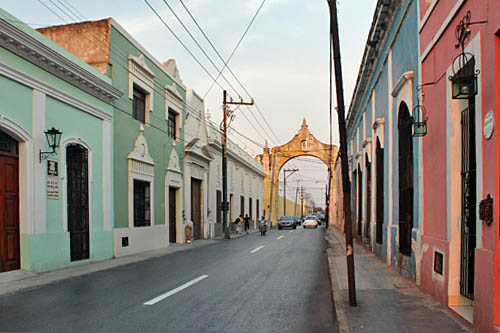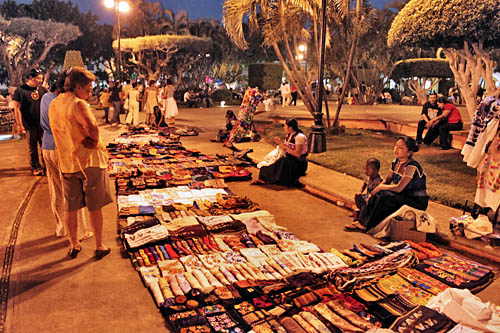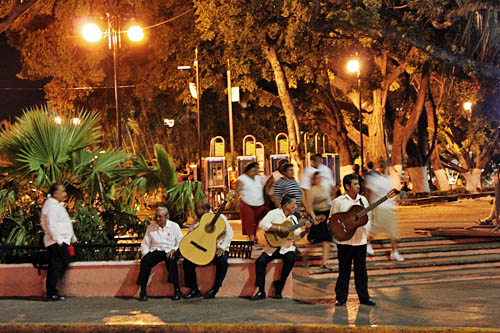I pressed my nose to the bus window as we rolled into Merida, one of the places in Mexico that I had yearned to see for years. My brow furrowed in disappointment; the city looked nothing like I had envisioned. With its location in the northwestern corner of the Yucatan, just inland of where the Gulf of Mexico meets the Caribbean, I had expected to see palm trees and sun-splashed cottages dripping in tropical colors. Instead, unbroken lines of flat-fronted buildings stood so close together that it was difficult to tell where one ended and the next began. Like haughty neighbors, they turned their backs, forming fortress walls that made claustrophobic canyons of the streets. As I climbed into a taxi, the unbroken row houses flushed briefly gold in the setting sun and then skulked into shadow.

Although I’d felt completely safe traveling around Mexico solo for the past few months, I was suddenly anxious about exploring this large, unfamiliar city after dark. By day the city had been intimidating; by night its dark streets seemed positively ominous. Fortunately, the hostel owner assured me that Merida is the safest city in the Republic, handed me a map, and told me to be sure to check out the artwork inside the Palacio de Gobierno on the Zocalo – the Main Plaza at the heart of the city. Four nerve-wracking blocks later I stepped out of the dark street and into a grand square bathed in yellow light, where indigenous Indians spread crafts on handmade blankets and romantic couples embraced in high white loveseats scattered around the plaza.


Over the next few days I learned that, in addition to being the geographic center of Merida, the Zocalo is also its cultural and spiritual core. Present day Merida is built atop the ancient Mayan city of T’Ho, which dates back to 3000 BC and was situated on what is today the Main Plaza. The Spaniards conquered T’Ho in 1532 and dismantled its megalithic pyramids, using the stones for the foundation of the Cathedral of San Ildefonso (1599), which still graces the east side of the Plaza and is the oldest cathedral on the American continent. Directly across the Plaza is the Palacio Municipal (1735), Merida’s Town Hall. On the south side is Casa de Montejo (1542), the former home of the conqueror of Yucatan. The Palacio de Gobierno (1892) on the north side displays 27 enormous murals depicting the bloody Caste Wars that resulted when the Mayans refused to accept Spanish rule.

To ensure that visitors enjoy their time in Merida and learn something of the history and culture of the Yucatan, the city sponsors a series of free and inexpensive events in and around the Zocalo:
- Monday: Join a free walking tour of the Plaza at 9:30 a.m.; visit the Casa de Artesanias (Mayan Handicraft House); do a colorful tour of the city on the colorful Carnavalito bus; and attend a free concert with traditional Yucatecan dancing and dress on the Main Plaza at 9 p.m.
- Tuesday: Dance to big band music of the 40’s in Santiago Park on the corner of 59 & 72 at 8:30 p.m. Free.
- Wednesday: Attend a show at the Olimpo Cultural center at 9 p.m., free. Take a ride in an horse-drawn, open-air buggy for a nominal fee.
- Thursday: Serenade at Santa Lucia Park, an open-air concert featuring Yucatecan dress, dance, music and folklore, at 9 p.m. at the corner of 60 & 55. Free.
- Friday: Visit the native markets around town by day; serenade at the main University building at the corner of 60 & 57 at 9 p.m., nominal fee.
- Saturday: Free Mexican Night at Paseo de Montejo & Calle 57 at 7 p.m., free. “Heart of Merida” Festival on the Main Plaza and up Calle 60 to Calle 53 from 9 p.m.to 1 a.m., free.
- Sunday: Stroll “Merida on Sunday,” a street festival on the Main Plaza and along Calle 60 to Santa Lucia Park. Streets are closed, live music, 9 a.m. to 9 p.m., free. Sidewalk art is displayed along Paseo de Montejo between Calle 35 & Perez Ponce, free.
Can’t view the above slide show of Merida, Mexico? Click here.
A few days of exploring its historic center completely reversed my earlier antipathy toward Merida. I immersed myself in the city’s culture and history, visiting art galleries and ancient pyramids. I grew to appreciate the city’s simple architecture, crafted from the Yucatan’s only available natural resource – limestone. I reveled in the rich regional food, including Mayan cuisine that made use of healthful indigenous ingredients such as the Chaya leaf, which is crushed and blended into a refreshing, deliciously tart green juice. And still there was so much more that I did not have time to see or experience. I left with regret, knowing that someday I would return for a much longer stay.

We’ll she is also wrong in describing a Mariachi group. Mariachis have nothing to do with the amount of people it makes up though they do tend to start at 5. Mariachi is a style of playing music and not a genre, they can play a trova, bolero or polka. A trio is made up of 3 people and they usually play Boleros, more native to Veracruz. Trovadores are similar to a Trio but tend to have different kinds of guitars. I think you will be really impressed on your next visit to Merida because they are about to completely renovate 9 blocks of the Historic Center, the Market Place, 3 corridors (may become pedestrian only)and the old Train Station into a giant green park as part of the 1st phase of rescuing the city center. Plus the renovation of Paseo de Montejo, a new teather called Mayapan and the National Mayan Museum.
http://www.yucatan.com.mx/20110720/nota-9/151221-contradicciones-sobre-la-plancha.htm
http://www.patronatocentrohistoricomerida.com.mx/Index.php/index.php/proyecto-centro-historico-patronato-bid/
Just so you can get an idea. I’m not spamming.
Hi Michael! Thanks so much for the information. I loved Merida the way it was, but these improvements sound like it will make the city one of the top destinations in Mexico. I constantly tell people to visit places other than Canun and Puerta Vallarta, as neither of these provide a real taste of Mexico. Merida is the real deal.
I, too, find Merida and environs so visually stimulating. Here’s an album I shared with my DC friends after my nearly 4-month stay in Merida earlier this year. In addition to the usual downtown stuff, it includes shots of carnival, Holy Week, visitors from back home and a week-long trip we (my wife and I) took to San Cristobal de las Casas in Chiapas.
http://picasaweb.google.com/lh/sredir?uname=blessingra&target=ALBUM&id=5468343456794806433&authkey=Gv1sRgCISxotmPyIjrkgE&feat=email
I too have fallen in love with Merida. I will be returning in January with my hubby and my best friend. She and I went to school there last year for a month. Can you believe, we were too busy to do all the fun things? So, this year all fun and no school. We love the people and everything of Merida!I would love to at least winter there, and possibly live there. We will see what enero brings!!!I loved this article. And the pix bring back lots of memories!Thanks!
Barbara, you’re first impression of Merida is exactly the way i felt when first I arrived. I now plan to live full time in Merida as I have purchased a home just blocks from the Zocalo Grande. Enjoy Asia!
Hi Constance! Well, when I come back I’ll email you and maybe we can get together for coffee. Would love to know the details about your decision to relocate to Mexico permanently.
You’re amazing to me, Barbara — the way travel seems to re-charge you, instead of exhausting you. Wonderful post, photos.
Thank you Ruth. It’s true, whenever I’m not traveling I feel drained and restless, but the moment I get back on the road I’m totally refreshed. Thanks so much for the compliment – means a lot coming from you.
The sponsored events around the Zocala sound wonderful. If I visit Merida, that’s where you will find me, taking in the cultural exhibitions and dancing to the big band. I can see why you are considering Merida as a second home.
Donna: Well, you’ll just have to come visit me when I start wintering there! 🙂
Loved this article. Hope you do consider Merida as your final destination. Loads of great folks live there. You’ll have a great time! Come to Yucatan Living (http://www.yucatanliving.com) and take a look. Your blog will be in my News column this week. Come visit and see what I said about you! 🙂
Thank you Khaki: I’ll definitely stop by and check out your column. I’m back in the States for a few weeks, getting ready for a 5 month trip to Asia, but I’m already missing Mexico. Hope to be back next spring.
I love the fact that they even have a colorful bus too! Great list of things to do on the days of the week. I’m particularly intrigued by the big band dancing on Tuesdays – did you see any?
Sherry:
Unfortunately, there was so much to do in Merida that I didn’t get to see the big band dancing. Instead, I took an all-day tour to Uxmal, one of the stunning Mayan ruins in the area – but more on that later….
i’m sure that when the weather is cooler, things will liven up on some of those now empty streets
Palm trees and sun-splashed cottages dripping in tropical colors? The city of Merida is not situated on a beach. It’s historical center dates back to the 16th century, and is second in size to the historical center of Mexico City. The downtown houses are similar to the “row houses” found in many major cities, narrow in front, and going way back to a garden full of trees, fountains, and the well or “noria” needed to supply water. If you travel to the neighboring state Campeche, which is situated on the ocean, you will find the same type of construcion in its historical downtown, which is much smaller than Merida’s. You will also find some of the houses re-painted pistachio green and hot pink, albeit without the palm trees.
I am glad the end of your article had a more upbeat feeling to it.
PS: those are not mariachis in the picture, mariachis are native to the heartland of Mexico. They are a “trova”, which has 2 more members than a “trio”, and they play romantic Yucatecan ballads. They are found throughout Mexico’s southeast.
Hi Luisa: I was surprised by your comment. You apparently took away the impression that I did not like Merida. Quite the opposite. I loved it so much that it is one of two places I am considering spending my winters. My article was not meant to be downbeat, but to convey my initial impression upon first coming into Merida, since I had not previously been exposed to this type of architecture anywhere else in Mexico. But I think you can clearly read how much I grew to love this city! Thanks for the info about the mariachis – I will make the correction, though I did find mariachis troupes elsewhere in Mexico that had more than three members.
The streets of Merida totally remind me of Old San Juan in Puerto Rico, which I loved. The zocalo looks like a lot of fun.